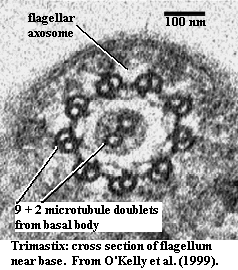
Trimastix: flagellum cross section, showing 9+2 doublets
| Glossary | ||
| Plants | Glossary D-K |
| Plant | Plant | Time |
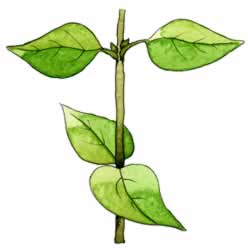
Deciduous falling off; in plants: shedding leaves annually.
Decussate branching pattern. Pattern in which successive pairs of branches (or leaves, etc.) are perpendicular to each other. Image from the Dr. Carol Brewer's (U. Montana) ECOS Guide to the Ecology of the Northern Rockies.
Dehiscence any process used to expel spores, microgametes, or seeds into the environment. To be more precise, dehisence refers to the steps which the plant performs to expose the seeds, etc. to the environment. Dispersal is the mechanism by which they are actually distributed in the environment. So, for example, moss spores may dehisce by the opening of the operculum and retraction of the peristomal teeth. They are then dispersed by wind. However some plants, like Sphagnum moss, may explosively dehisce and so get involved in dispersal as well.
Dichotomous branching a type of branching in which the tip divides into two more-or-less equal apices; by repetition of this type of branching in various planes distinctive shoot systems may be produced.
Dioecious used to describe plant species in which male and female sex organs are borne on separate individuals.
Diplobiontic relating to a life cycle in which the diploid and haploid generations are separate and morphologically distinct.
Diploid a nucleus is diploid if it contains two copies of each non-redundant gene. In Fungi, it is necessary to distinguish between diploid nuclei and diploid cells. A hypha may contain several haploid nuclei (either identical or from different individuals). Technically, the cell is diploid or polyploid. However, there may be no diploid nuclei.

Diplolepidous of moss sporophytes, having an inner (endostome) and outer (exostome) row of plates forming the peristome teeth. See Tree of Life: Bryopsida.
Diplolepidous-opposite of moss sporophytes, having an inner (endostome) and outer (exostome) row of plates forming the peristome teeth as radial elements between them. See Tree of Life: Bryopsida.
Dispersal to disperse: to dispel or scatter; in plants dispersal refers to mechanism of dispersing reproductive propagules like seeds or pollen.
Double fertilization in flowering plants: the more or less simultaneous union of one sperm and one egg to form a zygote (N=2) and another sperm with two polar nuclei to form triploid (N=3) endosperm in the ovule; in the Gnetales: the fusion of two sperm with two eggs to produce two zygotes, only one of which will mature into an embryo.
Double integument the two outermost layers of an ovule in angiosperms, one of which will differentiate into the seed coat; see integument.
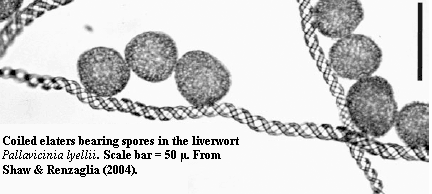
Elater Coiled structures, formed from one or more non-living cells, which are associated with spore dispersal in (for example) liverworts, hornworts, and the basal fern Equisetum. Elaters are hygroscopic. When exposed to moisture, elaters uncoil, separating spore tetrads and raising the spores for dispersal. Elaters in hornworts have spiral wall thickenings which may be homologous to thickenings in early tracheids, but lack lignin. Ligrone et al. (2000).
Embryo: "a stage in the life cycle during which the sporophyte is associated with and depends on the gametophyte." Ligrone et al. (2000).
Embryophyte the group of all organisms that retain the zygote on the parent to form an embryo, includes Bryophyta and vascular plants.
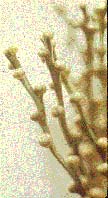
Enation a non-vascularized, epidermal outgrowth found in some early land plants.
Endarch "a type of xylem maturation in which protoxylem is internal to metaxylem and development prodeeds centrifugally (from the inside out)." Virtual Paleobotany Laboratory Glossary. Compare centrarch, exarch, mesarch.
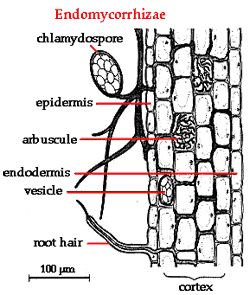
Endomycorrhizae a general type of symbiotic fungus, also called vesicular-arbuscular mycorrhizae (VAM). Endomycorrhizal fungi do not form a sheath around the roots. Instead, the fungus penetrates the cortical cells, although it does not penetrate the cell membranes. Endomycorrhizal fungi are zygomycotes. Endomycorrhizal associations form with about 70% of extant plants in nature, including all the grasses (but not sedges, which usually lack mycorrhizae), most herbaceous plants, and some trees. Probable endomycorrhizal fungi are associated with planys of the Rhynie Chert. See Endomycorrhizae (this entry is largely quoted from the cited page), in The Kingdom Fungi by Tom Volk. Image from the Tree Structure site of Professor Eric L. Singsaas, Univ. of Wisconsin, Stephens Point.
Endosperm the triploid (N=3) product of double fertilization in angiosperms; during seed maturation the endosperm will develop into a storage tissue that will provide nutrients to the seedling as it emerges (in monocots) or that will be digested and stored by the cotyledons before germination (in dicots)
Endospory a condition in which the gametophyte develops within the spore wall, rather than externally.
Endostome of moss sporophytes, the inner row of walls forming the peristome teeth. See Tree of Life: Bryopsida.
Endothecium the inner cell mass of the sporpphyte in basal plants. It usually produces both the central columella and the spores, which accumulate around the surface of the columella.
Entire margin in leaves, the condition in which the margin forms a smooth line or arc without noticeable serrations; note that lobed leaves can also have entire margins; compare to lobed margin and toothed margin.
Epidermis the exterior tissue, usually one cell thick, of leaves and young stems and roots.
Epigonium in mosses, a derivative of the archegonium which forms a hard, protective layer around the developing sporophyte. Later it breaks up, but the sporophyte retains a conical "dunce cap" or calyptra over its distal end. Strictly speaking, the term calyptra refers only to the "dunce cap," and the piece of the epigonium retained around the base (if any) is the vaginula.
Epiphyte a plant that grows on another plant, or which uses a rock or host plant merely as a place of residence and obtains its moisture and nutrients directly from the air; an air plant. A type of growth form. No parasitism is involved. The epiphyte is rooted on the surface of the host. Vines rooted in the soil and climbing up on another plant are not epiphytes.
Eusporangium sporangia that arise from a group of superficial cells; this is the primitive character state in vascular plants; compare to leptosporangium. "The eusporangium is usually large with a relatively thick wall comprising two or more cell layers, one of which may ultimately degenerate. Ontogenetically, the presence of a eusporangium is first recognized when a group of one or more rows of superficial cells begins to divide periclinally. Typical eusporangia occur in lycopsids and many other early fossil tracheophytes." Kenrick & Crane (1997).
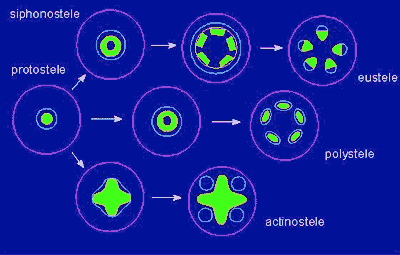
Eustele "eustele - the most common stelar arrangement in stems of living plants. Here, the vascular tissue is arranged in vascular bundles, usually in one or two rings around the central pith. In addition to being found in stems, the eustele appears in the roots of monocot flowering plants." Wikipedia: stele (biology). Image from Botany Online. In the image, the green regions are xylem, the other regions bounded in pale blue are phloem.
Evergreen opposite of deciduous, i.e. evergreen plants do not shed all their leaves annually, but shed and grow new leaves continually; most conifers are evergreen, but the evergreen habit is not restricted to conifers.

Exarch: protoxylem which is peripheral to metaxylem. Kenrick & Crane (1997). More generally, a directional/anatomical term describing a structure or tissue as being adjacent to, but more external, peripheral, radial, or further from a reference axis than some other structure or tissue. The word sometimes carries a slight suggestion that the inner tissue had something to do with inducing development of the exarch tissue. Opposite of endarch. Image adapted from The Virtual Plant. Compare centrarch, endarch, mesarch.
Exine "the outermost architecture of pollen walls, protects male gametes from the environment by virtue of its chemical and physical stability. ... Arabidopsis ... pollen grains have one of the most typical surface structures, namely a reticulate sculpture with uniform mesh size .... . This structure consists of inner intine, mainly made of cellulose and pectin, and outer exine, composed of sporopollenin, presumed to be a polymer of fatty acid derivatives and phenylpropanoids (Fig. 1B) [citations omitted]. Exine is composed of inner nexine and outer sexine. Sexine has a three-dimensional structure composed of many columns called baculae and a roof-like tectum that gives a reticulate appearance to the pollen surface. Nexine is divided into outer nexine I and inner nexine II based on differences in chemical components. Nexine I is composed of sporopollenin, like sexine, whereas the components of nexine II are unknown. In addition, a pollen coat, composed of adhesive compounds containing proteins and lipids, accumulates in cavities of the exine." Suzuki et al. (2008). The cited figure can be seen at this direct link.
Exosporic "Of spore germination where the first mitotic division occurs after rupture of the spore wall and outside the spore; gametophyte development outside the spore wall, i.e. the development of a free-living, multicellular gametophyte." exosporic.
Exostome of moss sporophytes, the outer wall of plates forming the peristome teeth. See Tree of Life: Bryopsida.
 |
| Trimastix: flagellum cross section, showing 9+2 doublets From O'Kelly et al. (1999).
|
Fiber cell a long-walled plant cell which is often dead at maturity; fibers impart elasticity, flexibility and tensile strength to plant structure
Fission cytoplasmic division of a cell to form two cells, a form of asexual reproduction.
Flagellum (pl.) flagella A eukaryotic flagellum is a bundle of nine fused pairs of microtubules called "doublets" surrounding two central single microtubules (the so-called 9+1 structure of paired microtubules; also called the "axoneme"). At the base of a eukaryotic flagellum is a microtubule organizing center about 500 nm long, called the basal body or kinetosome. The flagellum is encased within the cell's plasma membrane, so that the interior of the flagellum is accessible to the cell's cytoplasm. This is necessary because the flagellum's flexing is driven by the protein dynein bridging the microtubules all along its length and forcing them to slide relative to each other, and ATP must be transported to them for them to function. This extension of the cytoplasm is called the axosome.
Important note The eukaryotic flagellum is completely different from the prokaryote flagellum in structure and in evolutionary origin. The only thing that the bacterial, archaean, and eukaryotic flagella have in common is that they stick outside of the cell and wiggle to produce propulsion.
From Flagellum - Wikipedia.

Flower condensed reproductive shoot of flowering plants, generally consisting of four whorls from the outside in: sepal, petal, stamen, and carpel; the diversity of flower form comes from variation of the general four-whorled structure. Image from the Great Plant Escape site of the University of Illinois.
Foot another grossly over-used anatomical term. For botanical purposes, we use : "The foot is a specialized mass of tissue that develops early in the ontogeny of embryophytes, forms an intimate connection with the gametophytic tissues, and performs a nutritive function for the young sporophyte ... . Two distinctive types of foot form are recognized: a bulbous mass of tissue is the general condition in embryophytes, whereas an elongate tapering foot is characteristic of some mosses." Kenrick & Crane (1997).
Forb a small, upright soft-stemmed or non-woody plant with broadleaves; the growth form of many common wildflowers.
Form genus a genus name which does not correspond to a clade, but is used to describe a group of similar fossils. In paleobotany, form genera are used frequently. They typically refer to the fossilized remains of some part of a plant, when the actual genus of the plant is unknown. Thus, Stigmaria refers to fossil "root" (actually basal branch) systems from tree-like lycopsids of no particular genus. Other form genera are maintained for one generation (i.e. sporophyte or gemetophyte) of a plant or group of plants.
Frond leaf of a fern
Fusiform tapering towards each end; football-shaped
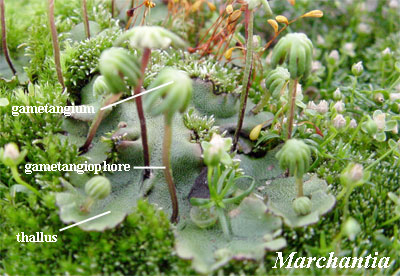
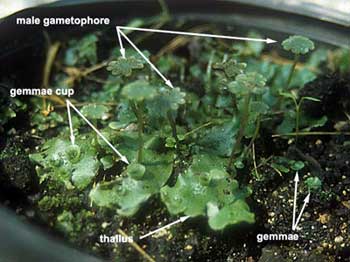
G-Type Tracheid See tracheid types.
Gametangiophore "An upright structure that bears the female gametes (see archegoniophore) or male gametes (see antheridiophore) in certain liverworts [and in some very basal tracheophytes]. Gametangiophores are extensions of the thallus... ." Dictionary of Botany. Image from de.wikipedia. The various gamet__ terms are not always used rigorously. However, as best we can tell, the gametophyte is the entire haploid organism, i.e. thallus plus gametangiophore plus any other attachments. The gametangiophore refers to the entire gamete-producing structure, including the stalk growing out of the thallus. The gametangium is the organ at the end of the gametangiophore which produces individual gametes. The gametes are equivalent to the eggs or sperm of animals. The term gametophore is generally used only when discussing higher plants (Tracheophyta). In tracheophytes, the gametophyte is not an independent organism. It is a simplified appendage of the sporophyte generation. Thus, the careful distinctions we have just made between gametophyte, gametangiophore, and gametangium are essentially meaningless in the context of higher plants. Hence the use of the vague term gametophore. In lower plants (mosses, liverworts and relatives), the case is frequently reversed. That is, the sporophyte is usually a simplified appendage which develops from a fertilized gamete but remains attached to the gametophyte. Finally, note that each of the gamet__ terms has some equivalent archegon__ term for the female and an antherid__ term for the male. For example, since the gametangiophore labelled in the image bears female gametes, it might be referred to as an archegoniophore.
Gametangium the sexual organ of the gametophyte generation -- either an antheridium ("male") or archegonium ("female"). See alternation of generations.
Gametophore the structure in tracheophytes which produces the gamete. In tracheophytes, it is usually pointless to distinguish between the gametangiophore (the structure which bears the sex organs) and the gametangium (the sex organ which produces gametes) because the whole gametophyte generation is not a separate organism from the sporophyte. The gametophyte in tracheophytes has no separate structures for vegetative growth. Consequently, the whole gametophyte is regarded as an organ of the sporophyte, the gametophore.
Gametophyte the haploid phase (n = 1) of the life cycle, during which gametes (reproductive cells) are produced.
Gemma (pl. gemmae) a bud (or simply a group of cells) from which plants vegetatively reproduce.
Growth form the overall morphology of a plant species, including its stature, leaf type, and habit. The general description of the type of growth exhibited by a plant, such as herbaceous, shrubby (bush-like) and arborescent (tree-like). The most basic grow forms are trees, shrubs, forbs, and graminoids; but there are many more specialized growth forms such as epiphytes, lianas, and stem succulents.
Haploid a nucleus is haploid if it contains only one copy of each non-redundant gene. The great majority of animals, and higher plants, are diploid. That is, the form we usually observe has two copies of each gene, one from each parent. In lower plants there are numerous exceptions to the rule. Furthermore, the gametophyte generation (see alternation of generations) is always haploid.
Herb any non-woody vascular plant; a category of plants including both forbs and graminoids (grasses). Hence the term "herbaceous" layer.
Herbaceous having the sort of growth form characteristic of a herb.
Heterogametes: male and female gametes that are morphologically distinguishable.
Heterosporous having two types of spores: megaspores and microspores.
Heterospory a condition in which an organism produces two different types and sizes of spores, viz. microspores and megaspores. As a reproductive strategy, heterospory involves the following steps: (1) The mature diploid plant (sporophyte) produces "male" and "female" spores. Typically, the plant produces numerous small "male" spores (microspores) and fewer, but larger "female" spores (megaspores). (2) The megaspores are usually retained on the sporophyte, where a haploid female gametophyte develops inside the spore. (3) The microspores may or may not be retained on the sporophyte. They develop into sperm-producing, haploid gametophytes. (4) The sperm are released into the environment, and dispersed between plants. (5) The sperm fertilize female gametophytes grown from megaspores, producing a diploid zygote (fertilized cell). (6) The zygote develops into an embryo and finally a new diploid sporophyte. Heterospory evolved a number of times among different ancient plants. Lycopsids, ferns, sphenopsids and progymnosperms all developed heterospory. Many of these plants also evolved into large trees. The obvious advantage for heterosporous trees is that their great height would enhance the dispersal of windborne microspores. Competition for light in the shady Archaeopteris forests, may have also have encouraged heterospory, since the macrospores, like seeds, included food reserves to assist early plant growth. Heterospory is generally regarded as the precursor to the evolution of seeds. Microspore dispersal and macrospore viability in pteridosperms thus become pollen dispersal and ovule viability in seed-bearing plants. The change in sexual reproduction from moisture-bound gametophytes to seeds-bearing sporophytes enable vascular plants to colonize drier habitats and upland environments, and also provided the embryo with a protective case against hungry invertebrate herbivores.

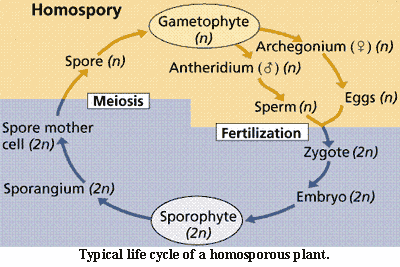
Heterotrichous (filament) a growth pattern of algae with prostrate filaments for attachment and erect, spreading filaments for photosynthesis.
Histological relating to tissue. Usually used to distinguish tissue-level organization or structure, as opposed to organization or structures at the molecular, cellular, organ, or organismal level.
Holdfast algal organ for attachment.
Homoplasy parallel evolution. The evolution of similar structures independently in two different lineages.
Homosporous having one type of spore. Compare heterospory.
Homospory a condition in which an organism produces only one type and size of spores, (microspores).
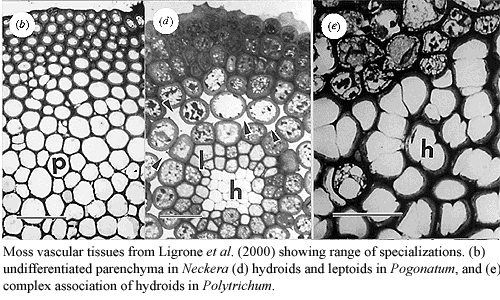
Hydroid The water storage or water vascular cells of Bryophyta. Analogous to xylem in tracheophytes.
Hygroscopic hygroscopic substances are those which extract water from the medium (usually referring to air).
Integument the outermost layer(s) of an ovule which will develop into the seed coat; most seed plant ovules have one integument, angiosperm ovules have two integuments (see double integument).
Intercalary meristem see meristem.
Isotomous branching pattern. Dichotomous branching with both branches essentially equal. Compare anisotomous.
checked ATW050802
modified ATW090409